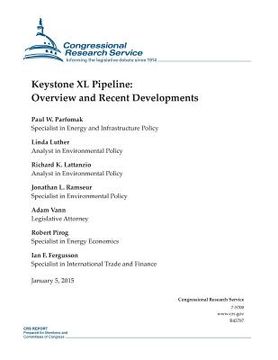Synopsis "Keystone XL Pipeline: Overview and Recent Developments (in English)"
TransCanada's proposed Keystone XL Pipeline would transport oil sands crude from Canada and shale oil produced in North Dakota and Montana to a market hub in Nebraska for further delivery to Gulf Coast refineries. The pipeline would consist of 875 miles of 36-inch pipe with the capacity to transport 830,000 barrels per day. Because it would cross the Canadian-U.S. border, Keystone XL requires a Presidential Permit from the State Department predicated on the department's determination that the project would serve the national interest. That determination considers environmental impacts, evaluated and documented in an environmental impact statement (EIS) pursuant to the National Environmental Policy Act (NEPA). TransCanada originally applied for a Presidential Permit for the Keystone XL Pipeline in 2008. An issue that arose during the permit review was environmental impacts in the Sand Hills region of Nebraska. This concern led the Nebraska legislature to enact new state pipeline siting requirements that would alter the pipeline route. The Presidential Permit was subsequently denied by the State Department. In May 2012, TransCanada reapplied for a Presidential Permit with a modified route through Nebraska. The new permit application initiated a new NEPA process. In January 2014, the State Department released the final EIS for the proposed Keystone XL Pipeline. The State Department subsequently began to focus on whether issuance of the permit would be in the national interest. To make such a determination, the department considers various factors related to the project and seeks input from members of the public and selected federal agencies. The public comment period closed in March 2014. In April 2014, the Department of State notified the other federal agencies that it would provide more time for their input due to ongoing litigation in the Nebraska Supreme Court challenging the state's approval of the altered pipeline route. Although the department stated that its review of the permit application would continue, many analysts viewed this notification as effectively suspending the permit review. Development of Keystone XL has been controversial. Proponents base their arguments primarily on increasing the diversity of the U.S. petroleum supply and economic benefits, especially jobs. Pipeline opposition stems in part from concern regarding the greenhouse gas emissions from the development of Canadian oil sands, continued U.S. dependency on fossil fuels, and the risk of a potential release of heavy crude. There is also concern over how much crude oil, or petroleum products refined from Keystone XL crude, would be exported overseas. Relations between the U.S. and Canadian governments have also been an issue. With the fate of Keystone XL uncertain, Canadian oil producers have pursued other shipment options, including other pipelines and rail. In light of what some consider excessive delays in the State Department's permit review, some in Congress have sought other means to support development of the pipeline. In the 113th Congress, the Energy Production and Project Delivery Act of 2013 (S. 17), the Northern Route Approval Act (H.R. 3), and the American Energy Solutions for Lower Costs and More American Jobs Act (H.R. 2) sought to eliminate the Presidential Permit requirement for Keystone XL. The Keystone for a Secure Tomorrow Act (H.R. 334) and a Senate bill to approve the Keystone XL Project (S. 582) would have directly approved the pipeline under the authority of Congress to regulate foreign commerce. A Senate amendment to the Fiscal 2014 Senate Budget Resolution (S.Con.Res. 8) would have provided for the approval of Keystone XL (S.Amdt. 494). The North American Energy Infrastructure Act (H.R. 3301) would have transferred permit authority for oil pipelines to the Department of Commerce, among other permitting changes.

